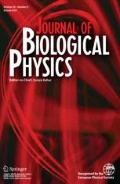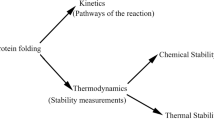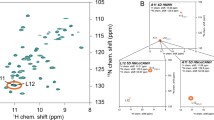Abstract
In theory, a polypeptide chain can adopt a vast number of conformations, each corresponding to a set of backbone rotation angles. Many of these conformations are excluded due to steric overlaps. Ramachandran and coworkers were the first to look into this problem by plotting backbone dihedral angles in a two-dimensional plot. The conformational space in the Ramachandran map is further refined by considering the energetic contributions of various non-bonded interactions. Alternatively, the conformation adopted by a polypeptide chain may also be examined by investigating interactions between the residues. Since the Ramachandran map essentially focuses on local interactions (residues closer in sequence), out of interest, we have analyzed the dihedral angle preferences of residues that make non-local interactions (residues far away in sequence and closer in space) in the folded structures of proteins. The non-local interactions have been grouped into different types such as hydrogen bond, van der Waals interactions between hydrophobic groups, ion pairs (salt bridges), and ππ-stacking interactions. The results show the propensity of amino acid residues in proteins forming local and non-local interactions. Our results point to the vital role of different types of non-local interactions and their effect on dihedral angles in forming secondary and tertiary structural elements to adopt their native fold.





Similar content being viewed by others
References
Ramachandran, G.N., Ramakrishnan, C., Sasisekharan, V.: Stereochemistry of polypeptide chain configurations. J. Mol. Biol. 7, 95–99 (1963)
Ramachandran, G.N., Sasisekharan, V.: Conformation of polypeptides and proteins. Adv. Prot. Chem. 23, 283–437 (1968)
Brocchieri, L., Karlin, S.: Geometry of interplanar residue contacts in protein structures. Proc. Natl. Acad. Sci. U. S. A. 91, 9297–9301 (1994)
Gunasekaran, K., Ramakrishnan, C., Balaram, P.: Disallowed Ramachandran conformations of amino acid residues in protein structures. J. Mol. Biol. 264, 191–198 (1996)
Walther, D., Cohen, F.E.: Conformational attractors on the Ramachandran map. Acta. Cryst. D 55, 506–517 (1999)
Ho, B.K., Brasseur, R.: The Ramachandran plots of glycine and pre-proline. BMC Struct. Biol. 5, 14 (2005)
Sasisekharan, V., Ponnuswamy, P.K.: Backbone and side chain conformations of amino acids and amino acid residues in peptides. Biopolymers 9, 1249–1252 (1970)
Rose, G.D., Gierasch, L.M., Smith, J.A.: Turns in peptides and proteins. Adv. Prot. Chem. 37, 1–109 (1985)
Venkatachalam, C.M.: Stereochemical criteria for polypeptides and proteins. V. Conformation of a system of three linked peptide units. Biopolymers 6, 1425–1436 (1968)
ElKettani, M.A.E.C., Zakrzewska, K., Durup, J., Lavery, R.: An analysis of the conformational paths of citrate synthase. Proteins 16, 393–407 (1993)
Vijayakumar, S., Vishveshwara, S., Ravishanker, G., Beveridge, D.L.: Differential stability of beta-sheets and alpha-helices in beta-lactamase: a high-temperature molecular dynamics study of unfolding intermediates. Biophys. J. 65, 2304–2312 (1993)
Betts, M.J., Sternberg, M.J.E.: An analysis of conformational changes on protein–protein association: implications for predictive docking. Protein Eng. 12, 271–283 (1999)
Hagler, A.T., Honig, B.: On the formation of protein tertiary structure on a computer. Proc. Natl. Acad. Sci. U. S. A. 75, 554–558 (1978)
Neha, V.K., Ramakrishnan, C., Balaram, P.: Sparsely populated residue conformations in protein structures: revisiting experimental Ramachandran maps. Proteins 82, 1101–1112 (2014)
Lakshmi, B., Sinduja, C., Archunan, G., Srinivasan, N.: Ramachandran analysis of conserved glycyl residues in homologous proteins of known structure. Protein Sci. 23, 843–850 (2014)
Saravanan, K.M., Krishnaswamy, S.: Analysis of dihedral angle preferences for alanine and glycine residues in alpha and beta transmembrane regions. J. Biomol. Struct. Dyn. 33, 552–562 (2014)
Tanaka, S., Scheraga, H.A.: Model of protein folding: inclusion of short, medium, and long-range interactions. Proc. Natl. Acad. Sci. U. S. A. 72, 3802–3806 (1975)
Gromiha, M.M., Selvaraj, S.: Influence of medium and long range interactions in different structural classes of globular proteins. J. Biol. Phys. 23, 209–217 (1997)
Gromiha, M.M., Selvaraj, S.: Importance of long-range interactions in protein folding. Biophys. Chem. 77, 49–68 (1999)
Selvaraj, S., Gromiha, M.M.: Importance of long-range interactions in (α/β)8 barrel fold. J. Prot. Chem. 17, 691–697 (1998)
Gromiha, M.M., Selvaraj, S.: Role of medium--and long-range interactions in discriminating globular and membrane proteins. Int. J. Biol. Macromol. 29, 25–34 (2001)
Gromiha, M.M., Selvaraj, S.: Comparison between long-range interactions and contact order in determining the folding rate of two-state proteins: application of long-range order to folding rate prediction. J. Mol. Biol. 310, 27–32 (2001)
Harihar, B., Selvaraj, S.: Refinement of the long-range order parameter in predicting folding rates of two-state proteins. Biopolymers 91, 928–935 (2009)
Harihar, B., Selvaraj, S.: Application of long-range order to predict unfolding rates of two-state proteins. Proteins 79, 880–887 (2011)
Kabsch, W., Sander, C.: On the use of sequence homologies to predict protein structure: identical pentapeptides can have completely different conformations. Proc. Natl. Acad. Sci. U. S. A. 81, 1075–1078 (1984)
Minor, D.L., Kim, P.S.: Context-dependent secondary structure formation of a designed protein sequence. Nature 380, 730–734 (1996)
Alexander, P.A., He, Y., Chen, Y., Orban, J., Bryan, P.N.: A minimal sequence code for switching protein structure and function. Proc. Natl. Acad. Sci. U. S. A. 106, 21149–21154 (2009)
Saravanan, K.M., Balasubramanian, H., Nallusamy, S., Selvaraj, S.: Sequence and structural analysis of two designed proteins with 88% identity adopting different folds. Protein Eng. Des. Sel. 23, 911–918 (2010)
Saravanan, K.M., Selvaraj, S.: Search for identical octapeptides in unrelated proteins: structural plasticity revisited. Biopolymers 98, 11–26 (2012)
Pace, C.N.: Conformational stability of globular proteins. Trends Biochem. Sci. 15, 14–17 (1990)
Ponnuswamy, P.K., Gromiha, M.M.: On the conformational stability of folded proteins. J. Theor. Biol. 166, 63–74 (1994)
Engin, O., Sayar, M., Erman, B.: The introduction of hydrogen bond and hydrophobicity effects into the rotational isomeric states model for conformational analysis of unfolded peptides. Phys. Biol. 6, 016001 (2009)
Fitzkee, N.C., Rose, G.D.: Sterics and solvation winnow accessible conformational space for unfolded proteins. J. Mol. Biol. 353, 873–887 (2005)
Ohkubo, Y.Z., Brooks, C.L.: Exploring Flory’s isolated-pair hypothesis: statistical mechanics of helix-coil transitions in polyalanine and the C-peptide from RNase A. Proc. Natl. Acad. Sci. U. S. A. 100, 13916–13921 (2003)
Cantor, C., Schimmel, P.: Biophysical Chemistry. WH Freeman, New York (2011)
Park, B., Levitt, M.: Energy functions that discriminate X-ray and near native folds from well-constructed decoys. J. Mol. Biol. 258, 367–392 (1996)
Keskin, O., Yuret, D., Gursoy, A., Turkay, M., Erman, B.: Relationships between amino acid sequence and backbone torsion angle preferences. Proteins 55, 992–998 (2004)
Porter, L.L., Rose, G.D.: Redrawing the Ramachandran plot after inclusion of hydrogen-bonding constraints. Proc. Natl. Acad. Sci. U. S. A. 108, 109–113 (2011)
Thornton, J.M.: Protein Folding. WH Freeman, New York (1992)
Singh, H., Chauhan, J.S., Gromiha, M.M., Open Source Drug Discovery Consortium, Raghava, G.P.: ccPDB: compilation and creation of data sets from protein data Bank. Nucleic Acids Res. 40, D486–D489 (2012)
Gromiha, M.M., Selvaraj, S.: Inter-residue interactions in protein folding and stability. Prog. Biophys. Mol. Biol. 86, 235–277 (2004)
Manavalan, P., Ponnuswamy, P.K.: Hydrophobic character of amino acid residues in globular proteins. Nature 275, 673–674 (1978)
Kyte, J., Doolittle, R.F.: A simple method for displaying the hydropathic character of a protein. J. Mol. Biol. 157, 105–132 (1982)
Tina, K.G., Bhadra, R., Srinivasan, N.: PIC: protein interactions calculator. Nucleic Acids Res. 35, W473–W476 (2007)
Burley, S.K., Petsko, G.A.: Aromatic-aromatic interaction: a mechanism of protein structure stabilization. Science 229, 23–28 (1985)
Overington, J.P., Johnson, M.S., Sali, A., Blundell, T.L.: Tertiary structural constraints on protein evolutionary diversity: templates, key residues and structure prediction. Proc. Roy. Soc. Biol. Sci. 241, 132–145 (1990)
Munoz, V., Serrano, L.: Intrinsic secondary structure propensities of the amino acids using statistical φ,ψ matrices: comparison with experimental scales. Proteins 20, 301–311 (1994)
Srinivasan, R., Rose, G.D.: LINUS: a hierarchic procedure to predict the fold of a protein. Proteins 22, 81–89 (1995)
Street, A.G., Mayo, S.L.: Intrinsic β-sheet propensities result from van der Waals interactions between side chains and the local backbone. Proc. Natl. Acad. Sci. U. S. A. 96, 9074–9076 (1999)
Berisio, R., Loguercio, S., De Simone, A., Zagari, A., Vitagliano, L.: Polyproline helices in protein structures: a statistical survey. Prot. Pept. Lett. 13, 847–854 (2006)
Wilmot, C.M., Thornton, J.M.: β-turns and their distortions: a proposed new nomenclature. Protein Eng. 3, 479–493 (1990)
Pal, D., Chakrabarti, P.: On residues in the disallowed region of the Ramachandran map. Biopolymers 63, 195–206 (2002)
Bartlett, G.J., Choudhary, A., Raines, R.T., Woolfson, D.N.: N-Π interactions in proteins. Nat. Chem. Biol. 6, 615–620 (2010)
Kraqelj, J., Ozenne, V., Blackledge, M., Jensen, M.R.: Conformational propensities of intrinsically disordered proteins from NMR chemical shifts. Chem. Phys. Chem. 14, 3034–3045 (2013)
Jensen, M.R., Zweckstetter, M., Huang, J., Blackledge, M.: Exploring free energy landscapes of intrinsically disordered proteins at atomic resolution using NMR spectroscopy. Chem. Rev. 114, 6632–6660 (2014)
Adzhubei, A.A., Sternberg, M.J., Makarov, A.A.: Polyproline II helix in proteins: structure and function. J. Mol. Biol. 425, 2100–2132 (2013)
Cubellis, M.V., Caillez, F., Blundell, T.L., Lovell, S.C.: Properties of polyproline II, a secondary structure element implicated in protein-protein interactions. Proteins 58, 880–892 (2005)
Makowska, J., Rodziewicz-Motowidlo, K., Makowski, M., Vila, J.A., Liwo, A., Chmurzynski, L., Scheraga, H.A.: Polyproline II conformation is one of many local conformational states and is not an overall conformation of unfolded peptides and proteins. Proc. Natl. Acad. Sci. U. S. A. 103, 1744–1749 (2006)
Hagarman, A., Mathieu, D., Toal, S., Measey, T.J., Schwalbe, H., Schweitzer-Stenner, R.: Amino acids with hydrogen-bonding side chains have an intrinsic tendency to sample various turn conformations in aqueous solutions. Chemistry 17, 6789–6797 (2011)
Jha, A.K., Colubri, A., Zaman, M.H., Koide, S., Sosnick, T.R., Freed, K.F.: Helix, sheet and polyproline II frequencies and strong nearest neighbor effects in a restricted coil library. Biochemistry 44, 9691–9702 (2005)
Toal, S., Schweitzer-Stenner, R.: Local order in the unfolded state: conformational biases and nearest neighbor interactions. Biomolecules 4, 725–773 (2014)
Swindells, M.B., MacArthur, M.W., Thornton, J.M.: Intrinsic phi, psi propensities of amino acids, derived from the coil regions of known structures. Nat. Struct. Biol. 2, 596–603 (1995)
Thornton, J.M., Jones, D., MacArthur, M., Orengo, C., Swindells, M.: Protein folds: towards understanding folding from inspection of native structures. Philos. Trans. R. Soc. Lond. Ser. B Biol. Sci. 348, 71–79 (1995)
Bellesia, G., Jewett, A.I., Shea, J.E.: Sequence periodicity and secondary structure propensity in model proteins. Protein Sci. 19, 141–154 (2010)
Munoz, V., Seranno, L.: Local versus nonlocal interactions in protein folding and stability – an experimentalist’s point of view. Fold. Des. 1, 71–77 (1996)
Thukral, L., Shenoy, S.R., Bhushan, K., Jayaram, B.: ProRegIn: a regularity index for the selection of native-like tertiary structures of proteins. J. Biosci. 32, 71–81 (2007)
Ponnuraj, K., Saravanan, K.M.: Dihedral angle preferences of DNA and RNA binding amino acid residues in proteins. Int. J. Biol. Macromol. 97, 434–439 (2017)
Zaman, M.H., Shen, M.Y., Berry, R.S., Freed, K.F., Sosnick, T.R.: Investigations into sequence and conformational dependence of backbone entropy, inter chain dynamics and the Flory isolated-pair hypothesis for peptides. J. Mol. Biol. 331, 693–711 (2003)
Ting, D., Wang, G., Shapovalov, M., Mitra, R., Jordan, M.I., Dunbrack Jr., R.L.: Neighbor-dependent Ramachandran probability distributions of amino acids developed from a hierarchical Dirichlet process model. PLoS Comput. Biol. 6, e1000763 (2010)
Espinoza-Fonseca, L.M., Llizalitturi-Flores, I., Correa-Basurto, J.: Backbone conformational preferences of an intrinsically disordered protein in solution. Mol. BioSyst. 8, 1798–1805 (2012)
Schwalbe, M., Ozenne, V., Bibow, S., Jaremko, M., Jaremko, L., Gajda, M., Jensen, M.R., Biernat, J., Becker, S., Mandelkow, E., Zweckstetter, M., Blackledge, M.: Predictive atomic resolution descriptions of intrinsically disordered hTau40 and α-synuclein in solution from NMR and small angle scattering. Structure. 22, 238–249 (2014)
Schweitzer-Stenner, R., Toal, S.E.: Construction and comparison of the statistical coil states of unfolded and intrinsically disordered proteins from nearest neighbor corrected conformational propensities of short peptides. Mol. BioSyst. 12, 3294 (2016)
Kauzmann, W.: Some factors in the interpretation of protein denaturation. Adv. Protein Chem. 14, 1–63 (1959)
Thomas, P.D., Dill, K.A.: Local and nonlocal interactions in globular proteins and mechanisms of alcohol denaturation. Protein Sci. 2, 2050–2065 (1993)
Dill, K.A., Truskett, T.M., Vlachy, V., Hribar-Lee, B.: Modeling water, the hydrophobic effect, and ion salvation. Ann. Rev. Biophys. Biomol. Struct. 34, 173–199 (2005)
Dasgupta, D., Kaushik, R., Jayaram, B.: From Ramachandran maps to tertiary structures of proteins. J. Phys. Chem. B 119, 11136–11145 (2015)
Acknowledgments
We thank the anonymous reviewers for constructive comments. KMS is supported by a National Post-Doctoral Fellowship (File No: PDF/2015/000276) by Science Engineering Research Board (SERB), Government of India under the mentorship of Prof. P. Karthe at University of Madras. SS thanks UGC for the award of Emeritus Fellowship (Grant No: F.6-6/2014-15/EMERITUS-2014-15-GEN-4545/(SA-II)).
Author information
Authors and Affiliations
Corresponding author
Ethics declarations
Conflict of interest
The authors declare that they have no conflicts of interest.
Rights and permissions
About this article
Cite this article
Saravanan, K.M., Selvaraj, S. Dihedral angle preferences of amino acid residues forming various non-local interactions in proteins. J Biol Phys 43, 265–278 (2017). https://doi.org/10.1007/s10867-017-9451-x
Received:
Accepted:
Published:
Issue Date:
DOI: https://doi.org/10.1007/s10867-017-9451-x




